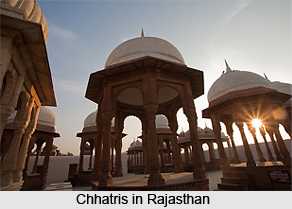 Chhatris or cenotaphs are quite common in Rajasthan. They had been built in the memory of brave Rajput warriors on the spot where they has sacrificed their lives or on the site of their funeral pyres. The Chhatris narrate the tales of those heroes who had accepted death with a smiling face rather than being humiliated. Chhatris are not the only commemorative monuments in Rajasthan. They are accompanied by the Sati marks that are often found on the walls of the fort. Sati practice referred to the self-immolation of women. It was believed that faithful wives would choose to follow their husbands in death. They would voluntarily throw themselves onto their husbands` funeral pyres.
Chhatris or cenotaphs are quite common in Rajasthan. They had been built in the memory of brave Rajput warriors on the spot where they has sacrificed their lives or on the site of their funeral pyres. The Chhatris narrate the tales of those heroes who had accepted death with a smiling face rather than being humiliated. Chhatris are not the only commemorative monuments in Rajasthan. They are accompanied by the Sati marks that are often found on the walls of the fort. Sati practice referred to the self-immolation of women. It was believed that faithful wives would choose to follow their husbands in death. They would voluntarily throw themselves onto their husbands` funeral pyres.
The structure of a Chhatris resembles the umbrellas or canopies. These are dome shaped and built on elevated pavilions. In Rajasthan the Chhatris are also built on the cremation sites of the affluent people. The structure of the Chhatris may differ from one dome supported by four pillars to a building consisting of many domes and an underground room with several rooms. In several places in the Shekhawati region the Chhatris are painted like the havelis. The interiors are also done in a similar fashion.
Some of the famous Chhatris in the Shekhawati region are:-
• Kirori
• Jhunjhunu
• Bissau
• Churu
• Parsurampura
• Fatehpur
• Ramgarh
• Mukungarh
• Mahansar
• Udaipurwati
• Dundlod
Besides this particular region Chhatris are also to be found in Jaipur, Jodhpur, Bharatpur, Haldighati, Alwar, Bundi, Bikaner and Nagaur. The Chhatris in Rajasthan are quite popular tourist destinations.






